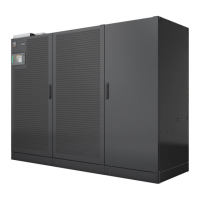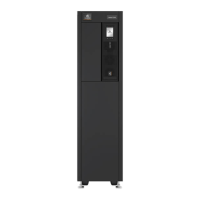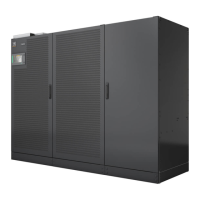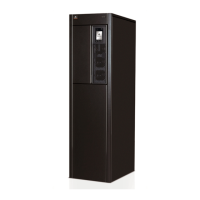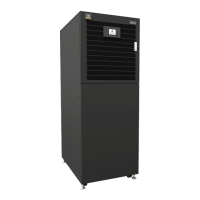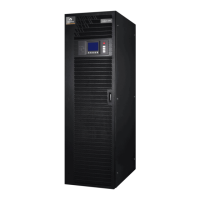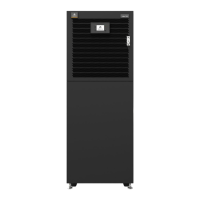Do you have a question about the Vertiv Liebert EXM and is the answer not in the manual?
Instructions for safe installation and operation of the Liebert EXM UPS.
Details the UPS control panel and its functions.
Procedures for inspecting equipment upon arrival.
Pre-installation checks before proceeding.
Guidance on selecting an appropriate location for the UPS.
Guidance on safely moving the UPS unit.
Details the UPS cabinet construction and features.
Provides physical dimensions of the UPS units.
Specifies required clearances around the UPS for ventilation and access.
Guidelines for installing the UPS on different floor types.
Describes how cables enter the UPS unit.
Information on optional battery and bypass cabinets.
Details the power module indicators and controls.
Shows connections for the static bypass assembly.
Guidelines for connecting power cables to the UPS.
Specifies torque values for connections.
Information on installing external protective devices.
Explains UPS input wiring configurations.
General guidelines for UPS cabling.
Details physical cable connections to busbars.
Information on fuses and back-feed breaker wiring.
Procedures for proper grounding of the UPS system.
Discusses necessary protective devices for UPS input.
Step-by-step guide for connecting cables.
Information on control cable connections and features.
Explains input and output dry contact signals.
Details output dry contact relays.
Describes the MBC interface at terminal block J26.
Details the battery cabinet interface at terminal block J22.
Information on the optional Emergency Power Off input.
Details communication card installation and options.
Information on the Web Card for network monitoring.
Provides remote UPS status via Ethernet.
Details the Relay Card for remote alarm monitoring.
Explains jumper settings for the Relay Card.
Overview of the UPS touchscreen interface and its functions.
Explains user access levels and security.
Lists default PINs for user access.
Lists and describes various UPS operating modes.
How the UPS operates on battery power.
Configuration for automatic UPS restart after power failure.
Operation of the UPS in bypass mode.
Energy-saving ECO mode operation.
Procedures for operating in maintenance mode.
How to adjust output voltage settings.
Setup for operation in generator mode.
Step-by-step guide to start the UPS.
Steps to start the UPS in Eco Mode.
How to switch between Normal and Bypass modes.
Procedure to switch to maintenance bypass.
Procedure to return to normal operation from bypass.
Steps to de-energize the UPS with a bypass cabinet.
Steps to de-energize the UPS without a bypass cabinet.
How to determine the UPS firmware version for parallel operations.
Procedures for parallel operations with Firmware v1.1.
Steps to re-energize a parallel system (Firmware v1.1).
Procedures for parallel operations with Firmware v1.0.
Steps to re-energize a parallel system (Firmware v1.0).
Procedure to isolate a single UPS in a parallel system.
Steps to re-energize a single UPS in a parallel system.
Procedure to place a parallel system in maintenance bypass.
Re-energize a parallel system online from maintenance bypass.
How to perform emergency shutdown using EPO.
Configuration for automatic restart after power failure.
Procedure to reset the UPS after shutdown conditions.
Information on battery protection features.
Explains the function of the static bypass switch.
Lists standards the UPS conforms to.
Specifies environmental conditions for operation.
Details electrical specifications of the UPS.
General safety guidelines for performing maintenance.
Identifies components with a limited lifespan and replacement recommendations.
Procedures for routine maintenance tasks.
Specifies torque values for electrical connections.
Guidance on identifying potential issues.
How to report issues to Vertiv Services.
Where to find corrective actions for alarms.
Lists recommended tools for maintenance and troubleshooting.
Instructions for safe installation and operation of the Liebert EXM UPS.
Details the UPS control panel and its functions.
Procedures for inspecting equipment upon arrival.
Pre-installation checks before proceeding.
Guidance on selecting an appropriate location for the UPS.
Guidance on safely moving the UPS unit.
Details the UPS cabinet construction and features.
Provides physical dimensions of the UPS units.
Specifies required clearances around the UPS for ventilation and access.
Guidelines for installing the UPS on different floor types.
Describes how cables enter the UPS unit.
Information on optional battery and bypass cabinets.
Details the power module indicators and controls.
Shows connections for the static bypass assembly.
Guidelines for connecting power cables to the UPS.
Specifies torque values for connections.
Information on installing external protective devices.
Explains UPS input wiring configurations.
General guidelines for UPS cabling.
Details physical cable connections to busbars.
Information on fuses and back-feed breaker wiring.
Procedures for proper grounding of the UPS system.
Discusses necessary protective devices for UPS input.
Step-by-step guide for connecting cables.
Information on control cable connections and features.
Explains input and output dry contact signals.
Details output dry contact relays.
Describes the MBC interface at terminal block J26.
Details the battery cabinet interface at terminal block J22.
Information on the optional Emergency Power Off input.
Details communication card installation and options.
Information on the Web Card for network monitoring.
Provides remote UPS status via Ethernet.
Details the Relay Card for remote alarm monitoring.
Explains jumper settings for the Relay Card.
Overview of the UPS touchscreen interface and its functions.
Explains user access levels and security.
Lists default PINs for user access.
Lists and describes various UPS operating modes.
How the UPS operates on battery power.
Configuration for automatic UPS restart after power failure.
Operation of the UPS in bypass mode.
Energy-saving ECO mode operation.
Procedures for operating in maintenance mode.
How to adjust output voltage settings.
Setup for operation in generator mode.
Step-by-step guide to start the UPS.
Steps to start the UPS in Eco Mode.
How to switch between Normal and Bypass modes.
Procedure to switch to maintenance bypass.
Procedure to return to normal operation from bypass.
Steps to de-energize the UPS with a bypass cabinet.
Steps to de-energize the UPS without a bypass cabinet.
How to determine the UPS firmware version for parallel operations.
Procedures for parallel operations with Firmware v1.1.
Steps to re-energize a parallel system (Firmware v1.1).
Procedures for parallel operations with Firmware v1.0.
Steps to re-energize a parallel system (Firmware v1.0).
Procedure to isolate a single UPS in a parallel system.
Steps to re-energize a single UPS in a parallel system.
Procedure to place a parallel system in maintenance bypass.
Re-energize a parallel system online from maintenance bypass.
How to perform emergency shutdown using EPO.
Configuration for automatic restart after power failure.
Procedure to reset the UPS after shutdown conditions.
Information on battery protection features.
Explains the function of the static bypass switch.
Lists standards the UPS conforms to.
Specifies environmental conditions for operation.
Details electrical specifications of the UPS.
General safety guidelines for performing maintenance.
Identifies components with a limited lifespan and replacement recommendations.
Procedures for routine maintenance tasks.
Specifies torque values for electrical connections.
Guidance on identifying potential issues.
How to report issues to Vertiv Services.
Where to find corrective actions for alarms.
Lists recommended tools for maintenance and troubleshooting.
| Product Type | UPS |
|---|---|
| Form Factor | Tower |
| Frequency | 50/60 Hz |
| Topology | Double-conversion online |
| Battery Type | VRLA |
| Communication Ports | RS-232, USB |
| Operating Temperature | 0°C to 40°C |
| Humidity | 0% to 95% non-condensing |
